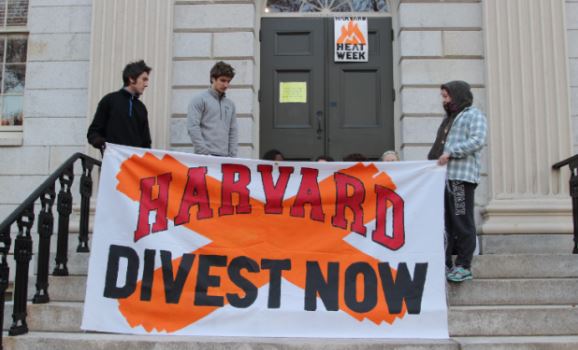In 2013, there was a groundswell of media coverage for a movement that had been gaining momentum since 2010; college students at campuses in developed nations were demanding that university endowment funds divest - sell their holdings -- from fossil fuel companies.
Divestment has had a long, proud cultural history, with the highest-profile example being South Africa during Apartheid in the 1980s. Fossil fuels have been a cause for concern for decades also, so it's no surprise the two met on university campuses. After a small amount of work, campaigns began to spring up. Humanities academics love to seem hip by latching onto new movements so some professors even gave credit to students who would protest investments in fossil fuels. An organization called 350.org, spearheaded by Bill McKibben, an environmental activist and Middlebury University visiting scholar in environmental studies, then took the movement on the road to other colleges.
Newspaper and magazine stories covered their efforts. Then the whole thing seemed to fizzle out without accomplishing much.
Oxford University was the most high-profile school to take up the challenge and promise to divest but there was just one problem with their endorsement of the movement; they had no fossil fuel holdings so all they really agreed to do was not buy any stocks directly. Even less convincing in their agreement to divest is that they actually get more in research funding from fossil fuel companies than they get from the United Kingdom government. Despite lots of media publicity, only 0.62 percent of higher education schools in the United States have divested, the largest being a community college in California. No Harvard, no MIT. Only one institution that is even in the U.S. News and World Report's top ten list has divested anything at all, the majority have simply chosen their own definition of divestment. Almost half of the schools that have divested aren't even ranked and some that have agreed to divest issued the press release and then forgot about it or engaged in a token gesture of selling a stock.
The New York-based National Association of Scholars calls the latter schools DINOs - divesters in name only. Oxford is on that list.
What went wrong with the movement and why do they still claim to have a thousand schools sympathizing with them? Part of the problem seems to be that the biggest promoter of divestment, 350.org, was essentially paying for protests and therefore getting false media attention. They offered "Fossil Free Fellowships" to students and sent full-time activists to schools and those full-time activists organized sit-ins. Given all that time and money, their efforts should have succeeded but as the University of Missouri learned last month, you can't always predict controversy so it is likely just as difficult to manufacture it.
And the failure of the divestment movement can also be regarded as cynicism by young people who have suffered "green fatigue" due to doomsday prophecy. Forty-six percent of American teens are so jaded by activism they don't believe in climate change, and it also true that college students are not as gullible as critics and opportunists like to believe.
They know they difference between a real green movement and the "astroturf" kind.
So do leaders at schools. Hundreds of schools give token recognition to divestment but the schools with the richest endowments have ignored the movement because they know what even activists have now conceded; it won't hurt fossil fuel companies in the least, any more than a national campaign to avoid buying gasoline today would make a difference in the bottom line of an oil company. The only real pain in divestment would be felt by university endowments so the only schools that will do it are the kind that can engage in such symbolism because they have little invested - 86 percent of schools that have divested have endowments that are tiny. Some schools are even ethical and refuse to hypocritically engage in it because caving into that kind of political "virtue signaling" would send the wrong message about the purpose of what has become an increasingly expensive higher education.
The school where the divestment movement started, Swarthmore College, has refused to divest. So did Middlebury College, the home of 350.org.
Believers note there is still time. They remind supporters that it took time for divestment due to Apartheid in South Africa to happen in the 1980s. What they leave out of the narrative is that college students and professional protesters didn't begin it; United States banks and the Gerald Ford administration had started that movement in the mid-1970s.




